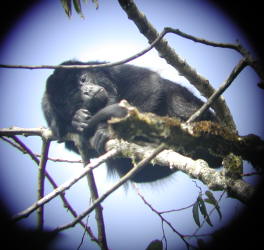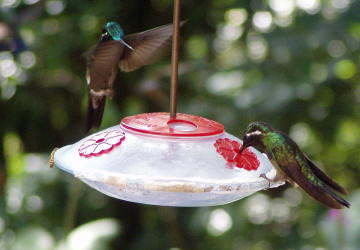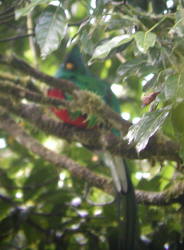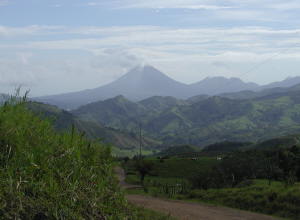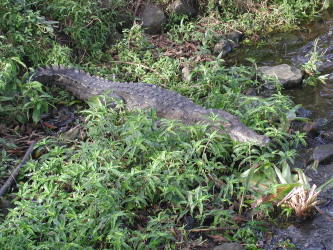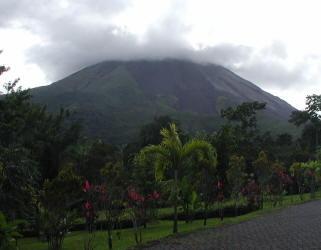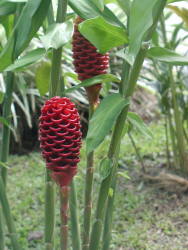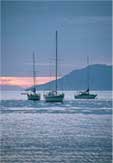
Logbook: Costa Rica Inland Travel to
Monteverde Cloud Forest Reserve & Volcan Arenal
December 12-16, 2006
| One of the really nice things
about email, and especially since cruisers can now send and receive email
onboard our boats, is that it has eased the sharing of information among the
cruising community. Prior to sailing to Costa Rica, we read numerous
emails from cruisers recommending a visit to Costa Rica's Monteverde Cloud
Forest Reserve and Arenal Volcano, saying these were highlights of this country,
so we wanted to make sure we didn't miss them.
Costa Rica covers an area of just under 20,000 square miles (51,000 sq km); it's about half the size of the U.S. state of Tennessee. Its topography is varied, with highlands 12,600 feet (3820 km) above sea level to coastlines along both the Pacific and Caribbean Seas. It has a population of 4.1 million, and most Costa Ricans are mestizo (a mix of Spanish and indigenous blood). Other population groups include blacks (less than 3% and concentrated on the Caribbean Coast), Chinese (1%) and indigenous (1%). North American and European immigration to Costa Rica has also greatly increased in recent years. Most Costa Rican's (75%) are Roman Catholic; 14% are Evangelical Christian; and the black population on the Caribbean coast is mostly Protestant. Costa Rica's primary industries are tourism (over a million visitors each year), coffee and microchip processing. |
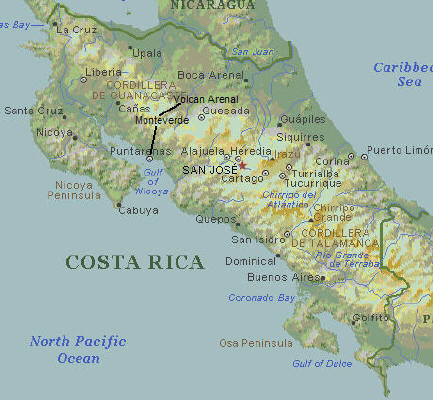 |
Costa Rica differs from its Central American neighbors in that it has avoided the internal turmoil experienced by the other countries in this region. The 1800's saw some unrest, including the defeat of William Walker, an American supported by Nicaragua's Liberal Party and who was intent on conquering Central America. There were also continuous power struggles between the church, state and coffee barons. However, this country's first elections were held in 1889, and the roots of democracy took hold. There was one lapse in 1917, when a dictator overthrew the president, but due to resistance, he fled the country a year later. Also, in 1948, there was a short civil war, but after that, Costa Rica abolished their armed forces. Costa Rica's president, Oscar Arias (1986-90), received a Nobel Prize for his peacekeeping efforts in Central America.
The lack of war, strong exports and tourism has meant a higher standard of living for Costa Ricans. The government provides impressive social services, such as free primary education and free healthcare, to its citizens, but those services have taken their toll on finances, and the country is deeply in debt.
Costa Rica has taken steps to protect its environment, but deforestation is still a problem. In the late 1940's, almost 90% of the country was covered by forests, but by the early 1990's, less than 25% of that remained. In an attempt to control this, the country has set up a National Park system, and today more than 14% of their country is within that system. Unfortunately, government funding is minimal, and enforcement of regulations are lax. However, the country rightfully boasts about its beautiful lush jungles, which are home to an incredible variety of birds, mammals, amphibians, reptiles, insects and plants.
We traveled to Monteverde and Arenal with our friends Aly and Iain on Loon III, who were great travel companions. We left Slip Away and Loon III in the care of the Costa Rica Yacht Club in Puntarenas while we traveled inland.
| Monteverde Cloud Forest Reserve From Puntarenas, we took a bus to Santa Elena, a small town close to the Monteverde Cloud Forest Reserve. It was a three hour bus ride, the first hour on a paved highway but the last two on a twisting, narrow and rough unpaved road. The community of Monteverde and Santa Elena was founded in 1951 by North American Quakers, who bought 1500 hectares (3700 acres) for dairy farming and cheese production. At that time, they preserved part of the property to protect the watershed. In 1972, another 2000 hectares (5000 acres) were added, and this became the Monteverde Cloud Forest Biological Reserve (Reserva Biológica Bosque Nuboso Monteverde). The elevation of this area is 1200 to 1600 meters (3960 to 5280 feet), and the weather is cool and damp, as one might expect of a cloud forest. At the recommendation of friends, we stayed at Pension Santa Elena, a backpacker's budget hotel. The folks at the pension were very helpful and arranged a guide for us the next day at the Reserve. |
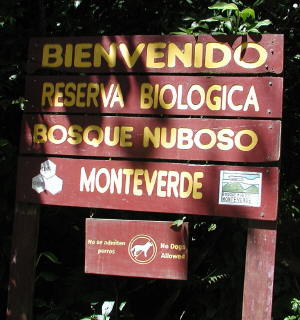 |
Since we were hoping for some good wildlife sightings, we needed to get to the Reserve early, which meant catching a bus at 6 a.m. The night before, we stopped in a grocery store and picked up some provisions for lunch the next day. In the morning, there was an excellent bakery that opened at 5:30 a.m., so we were able to have some breakfast and buy some freshly baked bread to take with us to the park.
We met our guide, Eduardo, at the park entrance at 7 a.m., and spent a half day hiking with him. Eduardo was full of information about the flora and fauna of the park (and Costa Rica in general). His enthusiasm for his profession was genuine, and we really enjoyed the time we spent with him. He brought a high-powered scope so that we could better see some of the wildlife. We saw monkeys, tarantulas and lots of birds, including the endangered and rare Resplendent Quetzal. Quetzals are rarely seen, and the park guides were as excited as the visitors about sighting one.
After our hike with Eduardo, he showed us a hummingbird garden just outside the park entrance. There are over 50 species of hummingbirds in Costa Rica and the population was quite dense at this hummingbird garden. As they buzzed around us, we sometimes felt like we were dodging kamikaze pilots, but they were quite beautiful. After Eduardo left us, we headed back into the park and hiked a trail to La Ventana ("window" in Spanish), where we stood on and enjoyed the view of the Continental Divide.
|
|
|
|
The next day, we visited Selvatura Park, which has eight suspension bridges that allow visitors to see the jungle canopy from above. We didn't see as much wildlife on this hike, but the jungle was beautiful and full of interesting sounds, and we spent several hours wandering through the park. This park also had a hummingbird garden, and again, we spent time watching and dodging these small birds as they fed from the nectar that was put out for them. That evening, we visited the "Frog Pond" which displays over 20 species of frogs and toads, and we all enjoyed that more than we expected to.
| Volcan Arenal After a couple of days in Monteverde, we traveled to Volcan Arenal, which is Costa Rica's most active volcano. From Santa Elena, we took a jeep taxi to Laguna Arenal (a man-made lake and Costa Rica's largest), which we crossed by boat, and then took another jeep taxi to our hotel. The trip took about 5 hours, and we passed through some beautiful countryside. Volcan Arenal was dormant for over 450 years (from about 1500 AD until July 1968), when huge explosions killed 78 people and about 45,000 head of cattle. Since then, it has continued to be active. |
|
We stayed one night at Hotel Los Lagos, which is situated quite near Arenal Volcano. (More than once, we questioned the wisdom of staying so close to an active volcano!) Hotel Los Lagos is a much nicer place than we would normally stay at when we are traveling on our "backpacker" budget, but friends recommended it because it is located at the foot of the road up which all of the tours take folks to view the spewing volcano. We could therefore hike up to the viewpoint ourselves instead of going on a tour. Staying at Hotel Los Lagos cost about the same as if we had stayed in a budget hotel in La Fortuna (the closest town) and taken a tour to the volcano. And, it was a nice treat for us to stay at a luxury hotel for a change!
Although our evening at Arenal Volcano wasn't a particularly clear one, we did see and hear the occasional burp of red hot lava roll down the side of the volcano. It was pretty spectacular! On the hotel grounds, there were a couple of pools and water slides (one pool was cool, but the other was thermally heated and about 90°F), and a walking path through some beautiful gardens with a few crocodiles (fortunately they were caged).
|
|
|
|
The next day, we stuffed ourselves at the wonderful breakfast buffet at Hotel Los Lagos before starting our journey home. To get back to Puntarenas, we traveled about six hours on two buses (connecting in San Ramon), but the roads were good, and we enjoyed just watching the scenery passing by. We'd had a great visit to the jungles of Costa Rica, but it was nice to get back to life on the sea.
